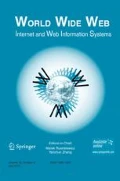Abstract
Blockchain technology is becoming familiar to the public, along with the widespread use of cryptocurrency. The blockchain protocol requires that full nodes need to save the complete blockchain data, which limits the joining of resource-constrained nodes. A small number of full nodes will reduce the decentralize and security of system. Elasticchain was proposed in 2018 to solve this problem by saving fragments of the entire blockchain in reliable nodes. However, Elasticchain does not give an effective method to evaluate the reliability of nodes. If the fragmented data is stored in unreliable nodes, such as malicious tampering, are often not online or the latency is too high, the security of blockchain system will be seriously impacted. Therefore, in this paper, we propose an ELM-based method to comprehensively evaluate node reliability, and the blockchain system distributes the fragmented data to reliable nodes for storage. In the new method, ELM is used as a classifier to select reliable nodes because the ELM has a higher performance of training and classification compared to other machine models. Moreover, in ELM classifier five novel evaluation features are considered: the security, the trustworthiness, the activeness, the stability and the communication costs. Finally, the experimental results on synthetic data demonstrate the accuracy and efficiency of the optimized data distribution model.







Similar content being viewed by others
References
Castro, M., Liskov, B., et al.: Practical Byzantine fault tolerance. In: OSDI, pp 173–186 (1999)
Cao, F., Liu, B., Park, D.S.: Image classification based on effective extreme learning machine. Neurocomputing 102(2), 90–97 (2013)
Chen, T., Teng, H u, Chen, J., et al.: DataEther data exploration framework for ethereum. ICDCS 2019, 1369–1380 (2019)
Dinh, T.T.A., Wang, J., Chen, G., Liu, R., Ooi, B.C., Tan, K.-L.: BLOCKBENCH: a framework for analyzing private blockchains. SIGMOD Conference 2017, 1085–1100 (2017)
Cui, D., Huang, Guang-Bin, Liu, T.: ELM based smile detection using distance vector. Pattern Recognit (79)356–369 (2018)
Extreme learning machine. https://www.ntu.edu.sg/home/egbhuang/ [DB/OL] [2020-10-27]
Frey, D., Makkes, M.X., Roman, P.-L., Taïani, F., Voulgaris, S.: Dietcoin: Hardening Bitcoin Transaction Verification Process For Mobile Devices. Proc. VLDB Endow. 12(12), 1946–1949 (2019)
Huang, G-B, Siew, C.K.: Extreme learning machine: RBF network case, 8th International conference on control, automation, robotics and vision. ICARCV, pp 1029–1036 (2004)
Huang, G-B, Zhu, Q-Y, Siew, C.K.: Extreme learning machine: Theory and applications. Neurocomputing 70(1-3), 489–501 (2006)
Hyperledger/fabric. https://github.com/hyperledger/fabric/blob/v0.6/examples/chaincode/go/chaincode_example02/chaincode_example02.go. [DB/OL] [2021-4-10]
Jia, D., Xin, J., Wang, Z., Guo, W., Wang, G.: An optimized data distribution model for elasticchain to support blockchain scalable storage. In: International conference on extreme learning machine (ELM), pp 76–85 (2018)
Jia, D., Xin, J., Wang, Z., Guo, W., Wang, G.: ElasticChain: support very large blockchain by reducing data redundancy. APWeb-WAIM 2018 (2), 440–454 (2018)
Kokoris-Kogias, E., Jovanovic, P., et al.: OmniLedger: a secure, scale-out, decentralized ledger via sharding. IEEE Symposium on Security and Privacy 583-598(2018), 2018 (2016)
Li, C., Deng, C., Zhou, S., Zhao, B., Huang, G-B: Conditional random mapping for effective ELM feature representation. Cogn. Comput. 10(5), 827–847 (2018)
Li, Y., Zheng, K., Yan, Y., Liu, Q., Zhou, X.: EtherQL: a query layer for blockchain system, database systems for advanced applications-22nd international conference. DASFAA 2017, pp 556–567 (2017)
Liang, N.-Y., Huang, G.-B., Saratchandran, P., Sundararajan, N.: A fast and accurate online sequential learning algorithm for feedforward networks. IEEE Trans. Neural Networks 17(6), 1411–1423 (2006)
Nakamoto S.: Bitcoin: A peer-to-peer electronic cash system, Consulted (2008)
Pedregosa, F., Varoquaux, G., et al.: Scikit-learn machine learning in python. J. Mach. Learn. Res. 12(10), 2825–2830 (2011)
Rioul, O., Magossi, J.C.: On Shannon’s formula and Hartley’s rule: beyond the mathematical coincidence. Entropy 16(9), 4892–4910 (2014)
Tang, J., Deng, C., Huang, G.-B.: Extreme Learning machine for multilayer perceptron. IEEE Trans. Neural Networks Learn. Syst. 27(4), 809–821 (2016)
Vo, H.T., Kundu, A., Mohania, M.K.: Research directions in blockchain data management and analytics. Proceedings of the 21th international conference on extending database technology, EDBT 2018, pp. 445–448 (2018)
Wang, S., Dinh, T.T.A., Lin, Q., et al.: ForkBase: an efficient storage engine for blockchain and forkable applications. Proceedings of the VLDB Endowment 11(10), 1137–1150 (2018)
Wang, X., Chen, A., Feng, H.-M.: Upper integral network with extreme learning mechanism. Neurocomputing 74(16), 2520–2525 (2011)
Xin, J., Wang, Z., Chen, C., Ding, L., Wang, G., Zhao, Y.: ELM*: distributed extreme learning machine with MapReduce. World Wide Web 17(5), 1189–1204 (2014)
Xu, Z., Han, S., Chen, L.: CUB, a consensus unit-based storage scheme for blockchain system. 2018 IEEE 34th International Conference on Data Engineering, ICDE 2018, pp 173–184 (2018)
Zhang, R., Xue, R., Liu, L.: Security and privacy on blockchain. ACM Comput. Surv. 52(3), 1–34 (2019)
Zhang, C., Xu, C., Xu, J., Tang, Y., Choi, B.: GEM2-Tree: A gas-efficient structure for authenticated range queries in blockchain. ICDE 2019, 842–853 (2019)
Zeng, Y., Li, Y., Chen, J., Jia, X., Huang, G.-B.: ELM embedded discriminative dictionary learning for image classification. Neural Networks (123)331–342 (2020)
Acknowledgements
This research was partially supported by the National Natural Science Foundation of China (No. 62072089), the Fundamental Research Funds for the Central Universities (Nos. N2116016, N2104001, N2019007, N180101028, N180408019 and N2024005-2), and the Open Program of Neusoft Corporation (No. NCBETOP2102).
Author information
Authors and Affiliations
Corresponding author
Additional information
Publisher’s note
Springer Nature remains neutral with regard to jurisdictional claims in published maps and institutional affiliations.
This article belongs to the Topical Collection: Special Issue on Emerging Blockchain Applications and Technology Guest Editors: Rui Zhang, C. Mohan, and Ermyas Abebe
Rights and permissions
About this article
Cite this article
Jia, D., Xin, J., Wang, Z. et al. ELM-based data distribution model in ElasticChain. World Wide Web 25, 1085–1102 (2022). https://doi.org/10.1007/s11280-021-00944-w
Received:
Revised:
Accepted:
Published:
Issue Date:
DOI: https://doi.org/10.1007/s11280-021-00944-w




